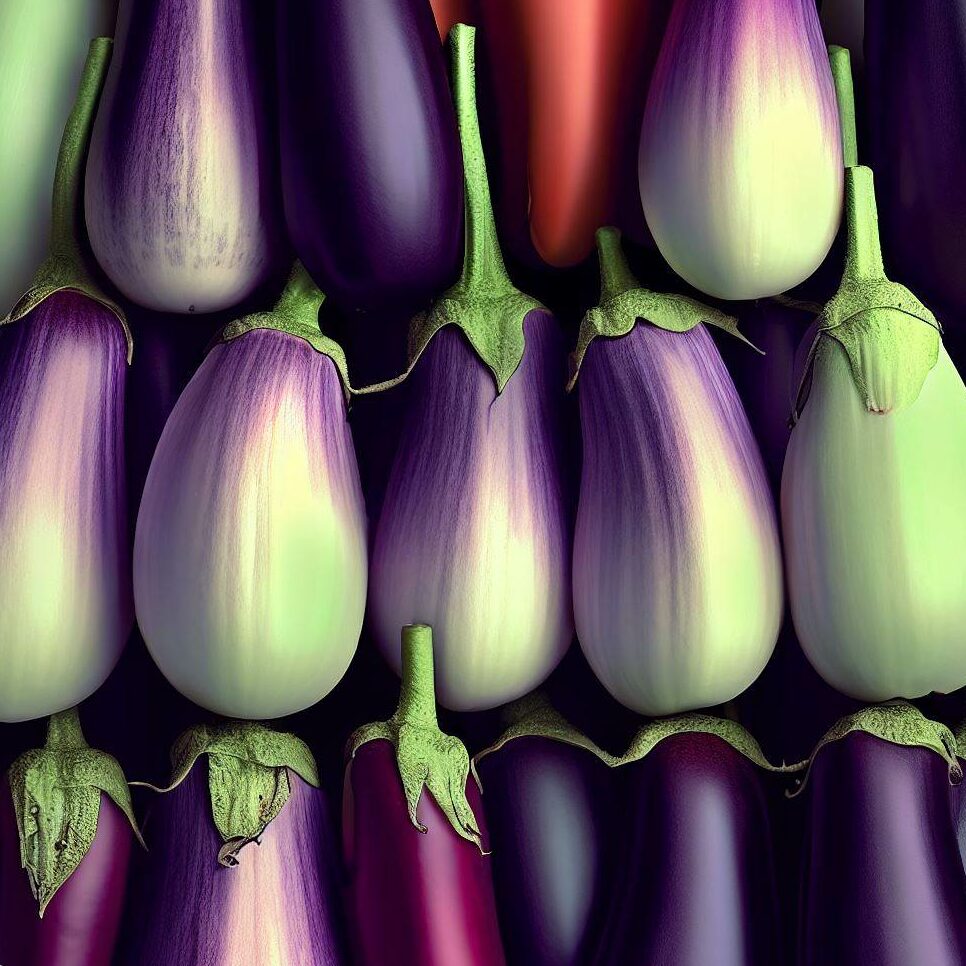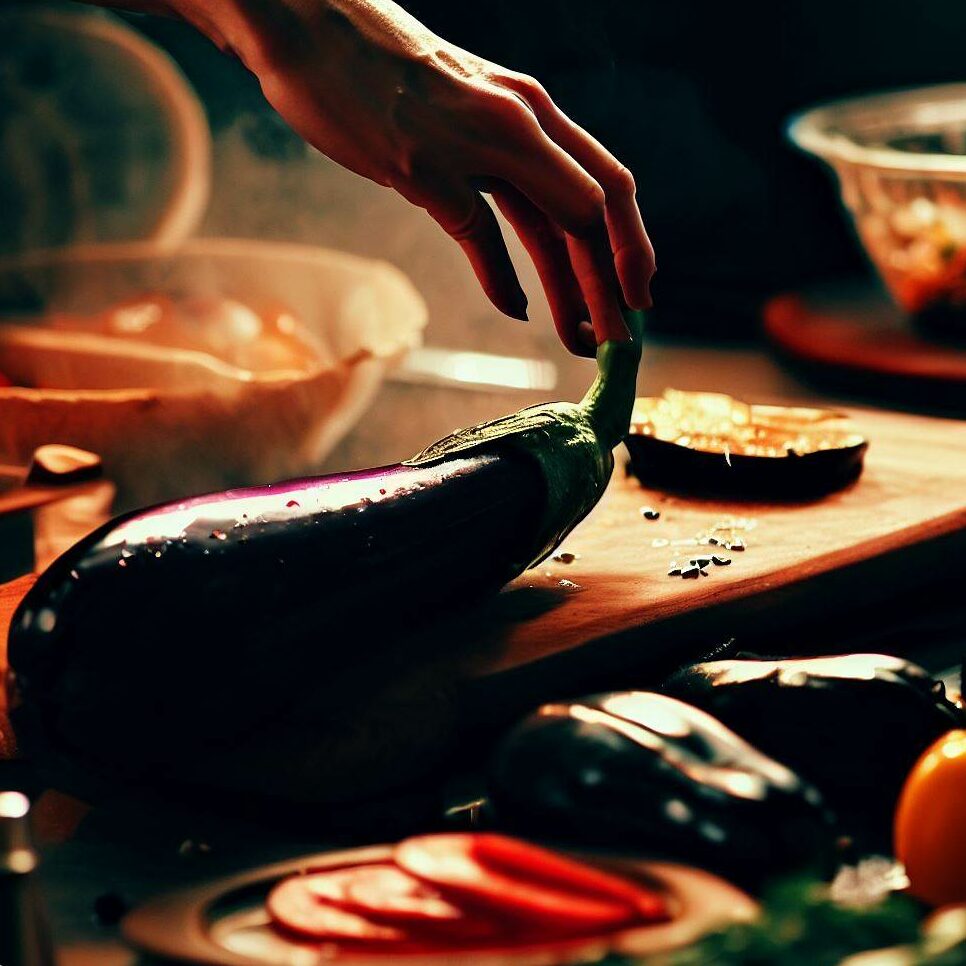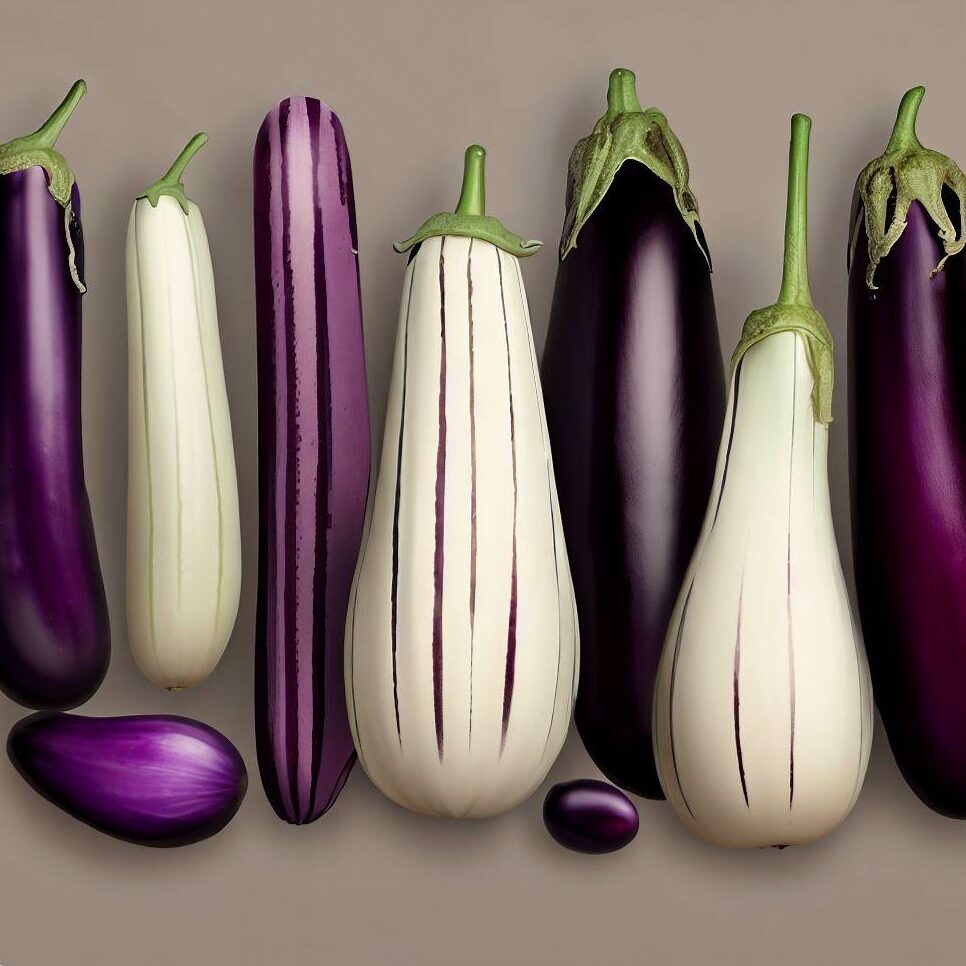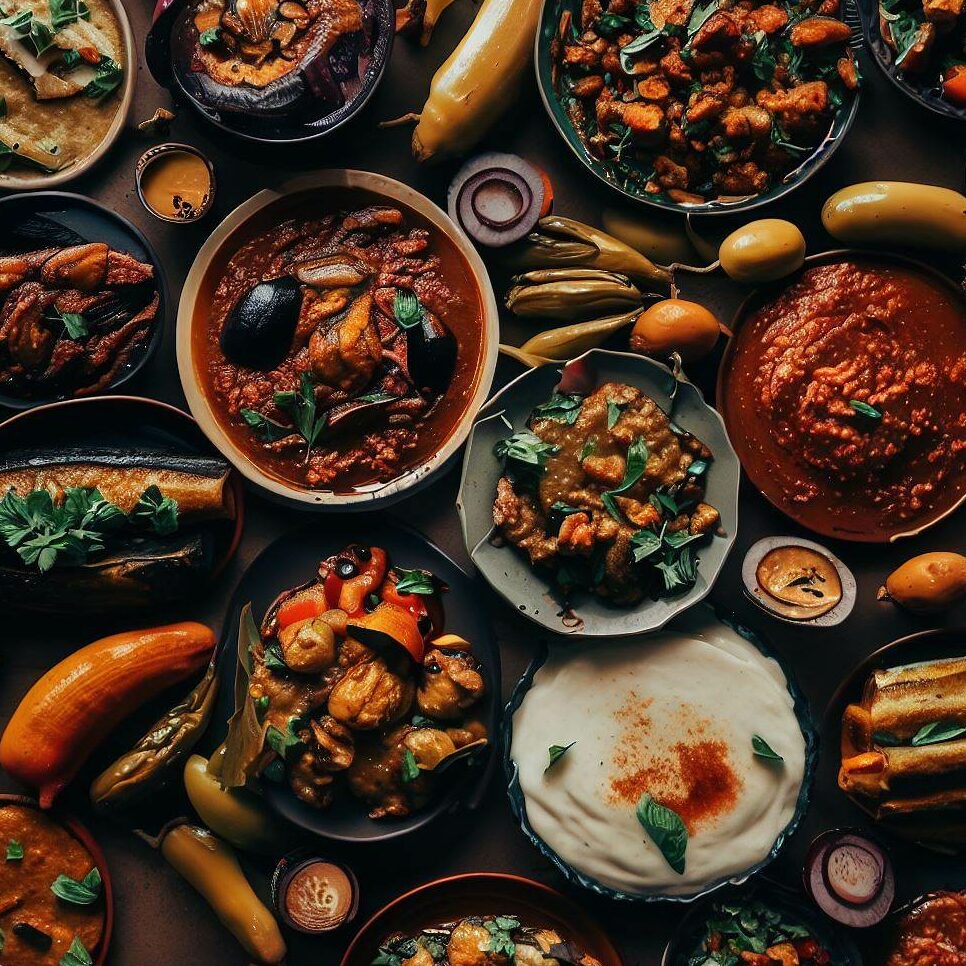Eggplants play a pivotal role in culinary arts worldwide. Their versatility is unmatched, finding their way into dishes from smoky baba ganoush to the rich layers of moussaka. But the secret to unlocking their full potential lies in one crucial step: selecting the perfectly ripe eggplant.
How can you tell if an eggplant is ripe? Look for a deep, glossy color, feel its firm yet slightly yielding texture, and check the seeds which should be light yellow. Overripe eggplants may have brown seeds and a bitter taste. Trust your senses and enjoy the rich flavors of a perfectly ripe eggplant in your culinary creations.

The Art of Eggplant Selection
Choosing the right eggplant can elevate a dish from ordinary to extraordinary. It’s not just about the taste; it’s about the texture, the aroma, and the overall experience. Here’s why:
- Texture: A ripe eggplant offers a tender yet firm bite, enhancing the mouthfeel of any dish.
- Flavor: The nuanced flavors of a ripe eggplant are both earthy and slightly sweet, making it a star in various recipes.
Versatility in the Kitchen
From Italian ratatouilles to Asian stir-fries, the eggplant’s adaptability is commendable. But to truly harness its potential, one must master the art of selection.
Pro Tip: Always opt for eggplants with smooth, glossy skin. It’s a telltale sign of its ripeness and freshness.
The Color Indicator
When it comes to eggplants, color is more than just a visual delight; it’s a direct window into the fruit’s maturity and readiness for your next culinary adventure.
Variety in Hue
Eggplants parade in a spectrum of colors, each hinting at its unique flavor profile and best use in the kitchen. Here’s a brief overview:
- Deep Purple: The classic shade most are familiar with, signaling a rich taste.
- White: A milder variant, often smaller and used in specific dishes.
- Striped: These eggplants wear their purple in stripes, offering a balanced flavor.
Spotting the Perfect Ripeness
Regardless of its variety, a ripe eggplant will always boast a deep, glossy sheen. This lustrous appearance isn’t just appealing to the eyes; it’s nature’s way of giving a thumbs up for culinary use.
Handy Hint: When shopping, give the eggplant a gentle squeeze. A ripe one will be firm but give slightly under pressure, complementing its vibrant hue.

Feeling the Texture
Beyond the vibrant hues, the true essence of an eggplant’s ripeness can be discerned through touch. The tactile experience, a dance of fingers on its skin, reveals tales of its maturity and readiness for the plate.
Decoding the Skin’s Tales
The skin of a ripe eggplant is a canvas of nature’s perfection. Smooth, devoid of wrinkles or blemishes, it’s akin to the polished surface of a well-kept antique. This impeccable texture is not just a mark of its freshness but also an indicator of its peak flavor profile.
Pro Tip: Always opt for eggplants with taut, glossy skin. Wrinkled or shriveled skin can indicate age or dehydration.
The Bounce-Back Test
One of the most telling signs of an eggplant’s ripeness is its response to a gentle press. When caressed with a thumb, a ripe eggplant should yield just a tad, like a sponge soaking up a droplet of water. But here’s the magic: it should bounce right back to its original form, showcasing its resilience and readiness.
- Firm yet Flexible: A ripe eggplant maintains a balance between firmness and flexibility.
- Overripe Warning: If the indentation remains post-press, it’s a sign the eggplant might be past its prime.
Handy Hint: The bounce-back test is a quick, on-the-go method, especially useful when you’re navigating a bustling farmer’s market or grocery store aisle.
The Seed Test
Peeling back the layers of an eggplant reveals a world of wonder, especially when it comes to its seeds. These tiny treasures hold clues about the fruit’s ripeness, offering insights that are both fascinating and essential for culinary enthusiasts.
Color Tells a Tale
When you slice open an eggplant, the seeds present their own color palette. A ripe eggplant typically boasts seeds of a light yellow hue, a sign that it’s reached its prime and is ready to grace your dishes.
Pro Tip: While the exterior of the eggplant provides initial clues, the seed color is a more definitive indicator of its maturity.

Brown Seeds: A Cautionary Note
Brown seeds in an eggplant are nature’s way of signaling caution. They often indicate that the eggplant is overripe, which might result in a bitter taste. While not harmful, it’s a taste profile some might prefer to avoid in their culinary creations.
Handy Hint: If you’re aiming for a sweeter dish, opt for eggplants with light yellow seeds. The brown-seeded ones can be reserved for dishes where a slightly bitter undertone complements the flavors.
Picking the Perfect Eggplant
In the world of eggplants, timing is everything. Just as a well-timed joke can elicit the heartiest of laughs, picking an eggplant at the right moment can make all the difference in your culinary creations.
The Golden Window of Ripeness
When an eggplant reaches its peak ripeness, it’s like nature’s little alarm bell ringing, signaling it’s time to pick. Harvesting eggplants as soon as they’re ripe ensures you capture their essence at its finest. This is when they’re bursting with flavor, boasting a texture that’s just right for cooking.
Pro Tip: Keep an eye on the eggplant’s skin. A glossy sheen is often a sign that it’s ready to be picked.
The Taste Spectrum
While slightly immature eggplants have a certain charm, offering a sweeter and tender bite, overripe ones tread on the bitter side. The latter can sometimes overshadow the dish’s other flavors, making it essential to strike the right balance.
Handy Hint: If you’re unsure about the ripeness, opt for the slightly immature ones. They’re versatile and can be a delightful addition to various dishes.
In essence, picking the perfect eggplant is an art, one that requires observation, understanding, and a dash of intuition. And when done right, the results on the plate are nothing short of spectacular.
Diverse Varieties of Eggplant and Their Ripeness Cues
Eggplants, known for their rich flavor and versatility in dishes, come in a delightful array of varieties. Each type, with its unique color and shape, adds a distinct touch to culinary creations. But does the same ripeness rule apply to all? In this section we’ll explore the diverse world of eggplants, from the smaller eggplant varieties, to the different colours and shapes.
Globe Eggplant
The most common variety, and the one we have already discussed. Globe eggplants are large, dark purple, and round. When ripe, they have a glossy finish and are firm to the touch.
Japanese Eggplant
Longer and thinner than the Globe variety, Japanese eggplants are dark purple. They should be firm and have a shiny skin when ripe.
Chinese Eggplant
Similar in shape to the Japanese variety but lighter in color, ranging from lavender to pink. Look for a glossy finish to determine ripeness.
White Eggplant
As the name suggests, these are white and can be round or elongated. They’re ripe when the skin is smooth and shiny.
Graffiti or Striped Eggplant
These are purple with white stripes and are typically teardrop-shaped. A glossy sheen indicates ripeness.

Thai Eggplant
Small and round, Thai eggplants can be green or white with green stripes. They’re ripe when they’re firm and bright in color.
Fairy Tale Eggplant
Tiny, purple, and white-striped, these eggplants should be firm and bright when ripe.
Pro Tip: While the general ripeness indicators like a glossy finish and firmness apply to most eggplant varieties, always consider the specific characteristics of each type. For instance, a ripe white eggplant won’t turn purple, but it will have a shiny finish.
Addressing Common Questions
The world of eggplants is as mysterious as it is delightful. Over the years, many have reached out to me with their pressing eggplant queries. Let’s demystify some of the most common questions together.
- How Do You Know When an Eggplant is Ready to Eat?
Trust your senses. A ripe eggplant will have a deep, glossy color and a firm yet slightly yielding texture when gently pressed. The skin should be smooth, and the overall feel should be weighty for its size. - Do Eggplants Ripen Off the Vine?
Unlike some fruits, eggplants don’t continue to ripen significantly once harvested. It’s best to pick them at their peak on the vine for optimal flavor and texture. - What Should Raw Eggplant Look Like?
Raw eggplants should have a vibrant color, free from large blemishes or sunken areas. The skin should be taut and glossy, not wrinkled or dull. - What Does a Ripe Eggplant Look Like Inside and Outside?
Externally, a ripe eggplant boasts a glossy finish. Internally, expect a creamy flesh with seeds that are pale yellow. Brown seeds often indicate overripeness. - Why Aren’t My Eggplants Ripening?
Several factors can affect ripening, including inadequate sunlight, inconsistent watering, or even pests. Ensure your plants receive ample sunlight and regular water.
Pro Tip: Rotate your eggplants gently every few days to ensure even sun exposure.
- Is Eggplant Ripe if Green Inside?
Some eggplant varieties are naturally green when ripe. However, for purple varieties, green flesh can indicate immaturity. It’s essential to know your eggplant type. - What Does Good Eggplant Look Like?
A good eggplant has a vibrant, uniform color, feels heavy for its size, and has a firm yet slightly yielding texture. The stem should be green and fresh-looking. - Is Overripe Eggplant Edible?
While overripe eggplants are edible, they can have a bitter taste and spongy texture. It’s best to use them in dishes where these characteristics can be masked, like in stews or sauces.
Handy Hint: If unsure about the ripeness, conduct a taste test by cooking a small piece before using the entire eggplant.
Eggplants, with their myriad varieties and uses, are truly a gift from nature. By understanding their nuances, we can enjoy them at their flavorful best.

Myths and Misconceptions
In our journey through the gardens of knowledge, we often stumble upon myths that cloud our understanding. Let’s shine a light on some of the misconceptions surrounding our beloved eggplants and set the record straight.
“Eggplant Smells Like Banana“
While both eggplants and bananas are nature’s treasures, they are distinct in aroma. Eggplants have a fresh, earthy scent, while bananas are sweet and fruity. If your eggplant has a strong, unusual odor, it might be past its prime.
Pro Tip: Always trust your nose. If an eggplant or any vegetable smells off, it’s best to avoid consuming it.
“Tiny Black Dots Inside Eggplant“
Occasionally, you might find tiny black dots inside an eggplant. These are simply concentrations of seeds and are perfectly safe to eat. They don’t indicate spoilage or disease.
The Color Inside: Green or Brown?
Many are taken aback when they slice open an eggplant to find green or brown flesh. While certain eggplant varieties are naturally green inside when ripe, brown can sometimes indicate overripeness or oxidation. However, a few brown spots near the seeds are normal and not a cause for concern.
Handy Hint: When encountering green flesh in a typically purple eggplant, consider the variety and age of the eggplant. It might just be a characteristic of that specific type.
Nature is diverse and ever-evolving, and so are the stories and beliefs we associate with it. By dispelling myths and embracing facts, we can appreciate the true essence of the plants we nurture and consume.
Conclusion
As we journey through the verdant fields of knowledge, we’ve unearthed the secrets of the enigmatic eggplant. From its vibrant hues to the tales its seeds tell, every aspect of this vegetable holds a story waiting to be discovered.
- Color: A deep, glossy shade is a beacon of ripeness.
- Texture: Seek out the gentle bounce-back of its skin.
- Seeds: Light yellow seeds whisper tales of perfect ripeness, while brown ones hint at tales of yore.
Selecting the perfect eggplant is as much an art as it is a science. While the signs and signals we’ve discussed will guide you, remember to trust your instincts. Nature has a way of speaking to those who listen.
Pro Tip: Embrace the journey of selecting and cooking with eggplants. Every dish tells a story, and with the right eggplant, yours will be a tale to remember.
May your culinary adventures with eggplants be as delightful as a stroll through a sun-kissed garden. Until our next botanical escapade, happy cooking!
